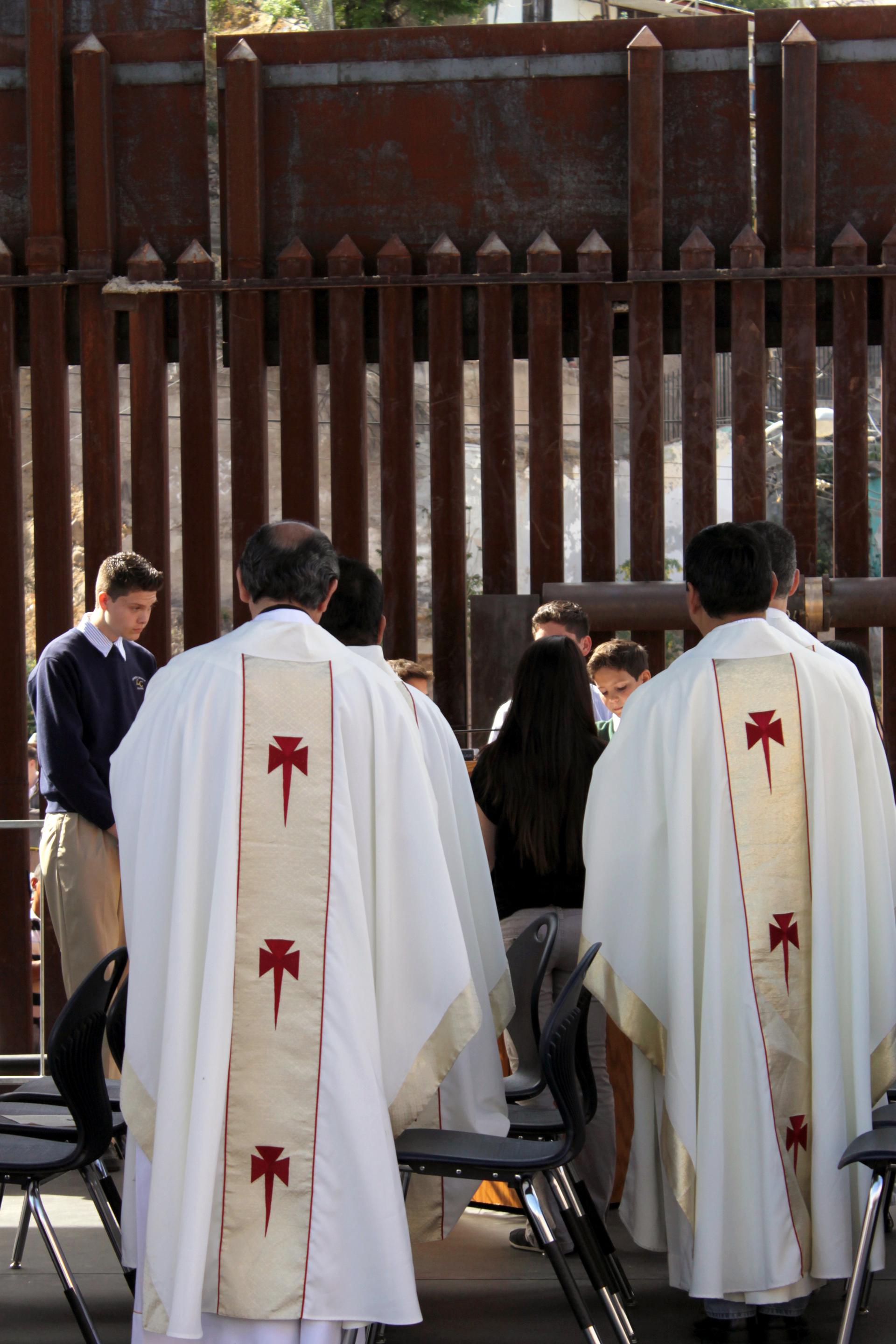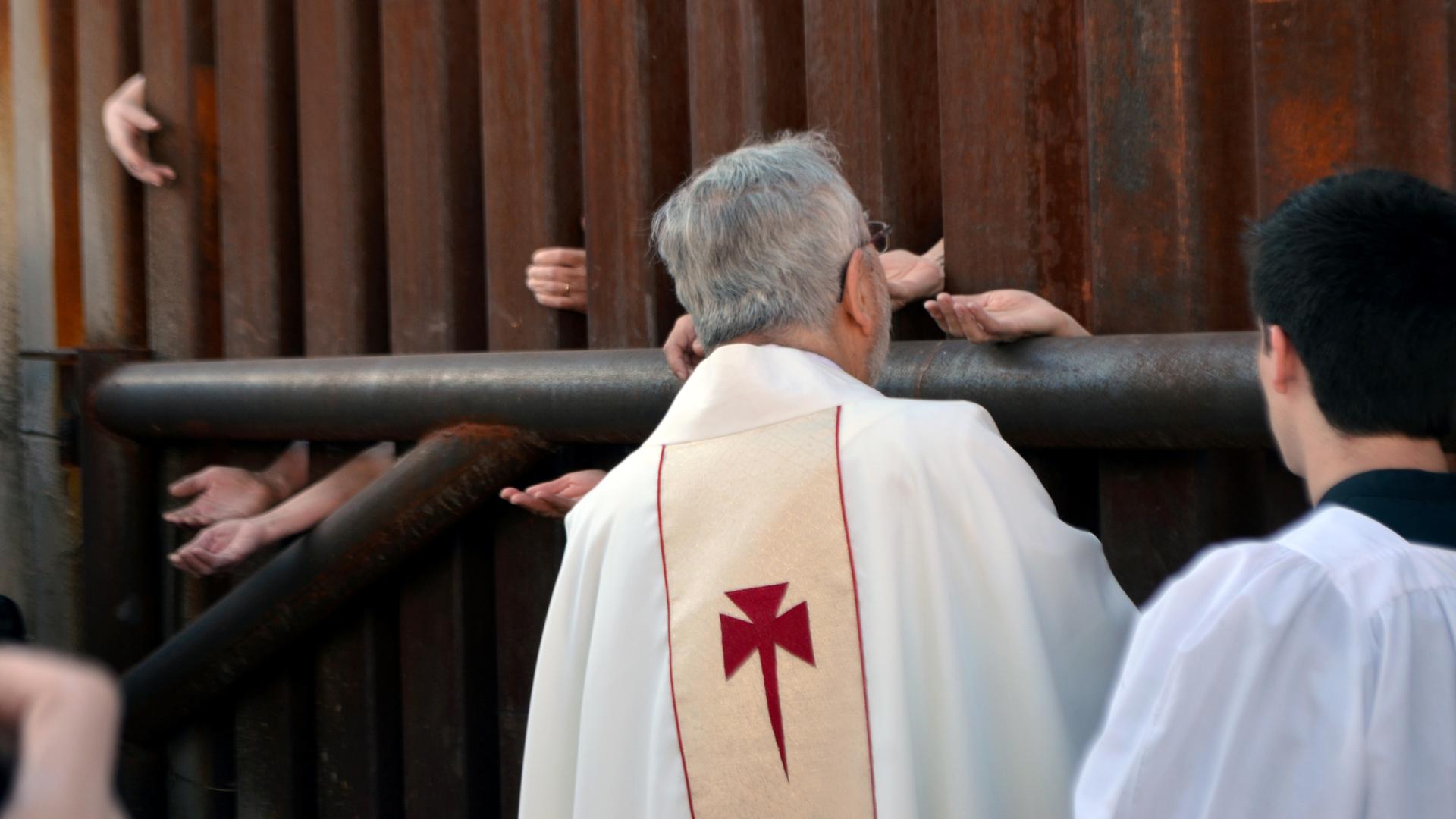Politics meets religion at a Catholic mass along the US-Mexico border
People on the Mexican side of the border reach through the fence into Nogales, Arizona, to receive Holy Communion from the Bishop of Tucson, Gerald Kicanas.
Last week, the United States Conference of Catholic Bishops (USCCB) conducted a mass along the US-Mexico border in Nogales, Arizona.
Standing in front of a 30-foot-high rusted gate that separates the US from Mexico, eight bishops, from El Paso to Atlanta, prayed in both Spanish and English. They faced a crowd of about 800 people on the American side. Behind them, on the Mexican side of the fence, a hundred or so people peeked through the slates.
On Tuesday, April 1, the bishops honored migrants who have died trying to cross the border. At last count, that number totaled 5,595, according to US Customs and Border Protection. And according to a report by the National Foundation for American Policy, there was a 27 percent increase in border deaths in 2012.
"We know the border is lined with unmarked graves of thousands of who die alone and nameless," said Boston's Archbishop Cardinal O'Malley during his homily. "We are here today to say they are not forgotten. Sometimes they are called illegal aliens, an expression that makes them sound like Martians. But they are our neighbors. They are our brothers and sisters."
The USCCB collaborated with the Kino Border Initiative, a bi-national organization that aims to create workable US-Mexican migration. Their teen program allows students from the Lourdes Catholic School to volunteer at a migrant soup kitchen and migrant shelter in the Nogales area. On Tuesday, Lourdes sent a little more than 200 of its students to sing, perform and speak during the mass.
My friend, Juan Gastelum, was born and raised in Nogales. He's a freelance journalist and also teaches at Lourdes. During the mass, Gastelum and one of his students, Andres Becerra, took photographs of the Catholic mass (see slideshow below). He said the students at Lourdes understand the dangers of the border, but it's also a part of everyday life growing up in Nogales.
 "About half the students here live in Mexico," he said. "Some are born in America, but live in Mexico." Everyday, Gastelum said a handful of the Lourdes students wait in security lines to cross the border, trailing into class well after the first bell. "It's not uncommon for us to have announcements on the intercom that say 'Teachers, please excuse late students coming in, the lines at the border were very long,'" Gastelum said.
"About half the students here live in Mexico," he said. "Some are born in America, but live in Mexico." Everyday, Gastelum said a handful of the Lourdes students wait in security lines to cross the border, trailing into class well after the first bell. "It's not uncommon for us to have announcements on the intercom that say 'Teachers, please excuse late students coming in, the lines at the border were very long,'" Gastelum said.
"A lot of people remember a time when this area of the border was more open. They have negative feelings of having so much surveillance here now," he told me. "It used to be that there was a closer connection to the other side of the border. Now, it takes a lot longer to cross and you have to go through more security. It really divides the town more, the more surveillance there is."
Fernanda Echavarri is a reporter with Arizona Public Media in Tucson. She reported on the mass and said the event was a real 'aha' moment.
"I didn't expect the turnout to be so huge. It was very interesting to have the backdrop of this event be this very familiar thing, a rusty border fence. And with the Catholic church, there's normally a routine for mass; it's all so contained, and this really broke that norm to have it be outdoors."
Echavarri said she spoke to a woman who worked for a church group that was based both in Montana and Mexico. "She told me, 'We know they are just on the other side, but we feel so divided.'"
The Catholic church has taken a strong stance in favor of immigration reform. In November the USCCB published a report about the increase in unaccompanied children crossing the border. And during his recent visit with President Barack Obama, Pope Francis emphasized the importance of immigration reform.
During the border mass, Auxiliary Bishop Eusebio L. Elizondo of Seattle said, "What we fail to remember in this debate is the human aspect of immigration, that immigration is primarily about human beings, not economic or social issues."
Last week, the United States Conference of Catholic Bishops (USCCB) conducted a mass along the US-Mexico border in Nogales, Arizona.
Standing in front of a 30-foot-high rusted gate that separates the US from Mexico, eight bishops, from El Paso to Atlanta, prayed in both Spanish and English. They faced a crowd of about 800 people on the American side. Behind them, on the Mexican side of the fence, a hundred or so people peeked through the slates.
On Tuesday, April 1, the bishops honored migrants who have died trying to cross the border. At last count, that number totaled 5,595, according to US Customs and Border Protection. And according to a report by the National Foundation for American Policy, there was a 27 percent increase in border deaths in 2012.
"We know the border is lined with unmarked graves of thousands of who die alone and nameless," said Boston's Archbishop Cardinal O'Malley during his homily. "We are here today to say they are not forgotten. Sometimes they are called illegal aliens, an expression that makes them sound like Martians. But they are our neighbors. They are our brothers and sisters."
The USCCB collaborated with the Kino Border Initiative, a bi-national organization that aims to create workable US-Mexican migration. Their teen program allows students from the Lourdes Catholic School to volunteer at a migrant soup kitchen and migrant shelter in the Nogales area. On Tuesday, Lourdes sent a little more than 200 of its students to sing, perform and speak during the mass.
My friend, Juan Gastelum, was born and raised in Nogales. He's a freelance journalist and also teaches at Lourdes. During the mass, Gastelum and one of his students, Andres Becerra, took photographs of the Catholic mass (see slideshow below). He said the students at Lourdes understand the dangers of the border, but it's also a part of everyday life growing up in Nogales.
 "About half the students here live in Mexico," he said. "Some are born in America, but live in Mexico." Everyday, Gastelum said a handful of the Lourdes students wait in security lines to cross the border, trailing into class well after the first bell. "It's not uncommon for us to have announcements on the intercom that say 'Teachers, please excuse late students coming in, the lines at the border were very long,'" Gastelum said.
"About half the students here live in Mexico," he said. "Some are born in America, but live in Mexico." Everyday, Gastelum said a handful of the Lourdes students wait in security lines to cross the border, trailing into class well after the first bell. "It's not uncommon for us to have announcements on the intercom that say 'Teachers, please excuse late students coming in, the lines at the border were very long,'" Gastelum said.
"A lot of people remember a time when this area of the border was more open. They have negative feelings of having so much surveillance here now," he told me. "It used to be that there was a closer connection to the other side of the border. Now, it takes a lot longer to cross and you have to go through more security. It really divides the town more, the more surveillance there is."
Fernanda Echavarri is a reporter with Arizona Public Media in Tucson. She reported on the mass and said the event was a real 'aha' moment.
"I didn't expect the turnout to be so huge. It was very interesting to have the backdrop of this event be this very familiar thing, a rusty border fence. And with the Catholic church, there's normally a routine for mass; it's all so contained, and this really broke that norm to have it be outdoors."
Echavarri said she spoke to a woman who worked for a church group that was based both in Montana and Mexico. "She told me, 'We know they are just on the other side, but we feel so divided.'"
The Catholic church has taken a strong stance in favor of immigration reform. In November the USCCB published a report about the increase in unaccompanied children crossing the border. And during his recent visit with President Barack Obama, Pope Francis emphasized the importance of immigration reform.
During the border mass, Auxiliary Bishop Eusebio L. Elizondo of Seattle said, "What we fail to remember in this debate is the human aspect of immigration, that immigration is primarily about human beings, not economic or social issues."
